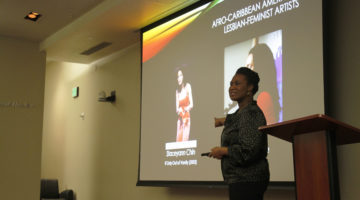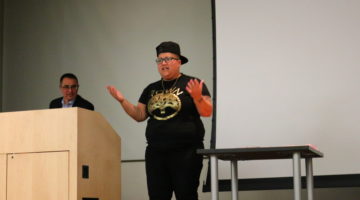Performance artist and author Tim Miller stopped by the Redfield Studio Theatre for a one-week residency. Put on by the Department of Theatre and Dance, students in the arts assembled on Thursday, April 4, for a night of stories and artistic insights from Miller’s latest release “Body in the O.”
Miller’s work involves exploring all facets of his identity as a gay man. His spiritual and personal creations have been shown all over North America, Australia and Europe. Miller has years of teaching performance at a plethora of universities across the U.S. and is the co-founder of two of the most influential performance centers in the country. On top of his prestige in performing, Miller has written the books “Shirts & Skin” and “Body Blows, 1001 Beds.”
Miller was awarded an NEA Solo Performer Fellowship in 1990. Along with three other artists, this honor was soon overturned from the Bush Administration due to gay themes in their work. Known as the “NEA 4,” these artists were successful in suing the federal government with the help of the ACLU due to a violation of their First Amendment rights. This particular experience exhibits only an ounce of how much Miller’s work has inspired over the years.

Internationally acclaimed performance artist and writer Tim Miller had a one-week residency in the Redfield Studio Theatre. Performing excerpts from his latest release ,“A Body in the O”, Miller shared stories relating to his experiences as a gay man in America.
Miller started the night off by explaining the origins behind the concept of “Body In the O.” The cover is a picture of him inside the ‘O’ of the famous Hollywood sign. The notion of the ‘O’ stems from the Shakespeare play “Henry V.” To Miller, the ‘O’ represents our ability to challenge the great events of our time and to create work that is happening right at this moment.
Throughout the years, Miller recalls theatre artists acting as first responders to worldwide events. He explains this proposition by sharing anecdotes from crucial events in our history. Before The New York Times mentioned the AIDS crisis and way before former President Ronald Reagan even uttered the phrase, theatre artists were bringing about awareness of the epidemic.
The lights were dimmed with the spotlight shining on just Miller himself. All the audience needed were his expressions and profound awareness of the inner workings of the world at the moment. His performance effortlessly intermixed humor amongst the seriousness of the topics.
One of the pieces he presented revolved around June 26, 2015 –– the day the Supreme Court decided in favor of marriage equality across all fifty states. Miller explains how this decision was not only monumental to couples all around the country but for binational couples as well. Miller was now able to submit a green card application for his husband.
It was infectious how Miller described the elation and sense of victory surrounding that day because of the years he’s spent performing and protesting in front of the steps of Homeland Security. He described this feeling as musical and like a dream. Miller referenced the play “Angels in America” with surrounding the piece around the quote “we will be citizens.”
Inspired by having to get an echocardiogram after seeing a theatre named after a cemetery in the hometown he grew up in, Miller seamlessly connected the experience of this examination with certain aspects of his life. He went in depth explaining his family history with heart problems and creatively drew this into his explanation as to why theater is “a place for being born.” This performance was an incredible demonstration of true art, making a simple event somehow connect to the deeper aspects of life.
Miller ended the performance with a Q&A portion. One particular question from an audience member revolved around how Miller’s creative process and how this process has changed over the years. Miller expressed what motivates him to grow as an artist, which was the need to respond to crisis right away and maintain a connection with the community.
The night turned out to be an eye-opening experience filled with incredible words. More than anything, Miller conveyed to the audience the power that theatre holds. If artists keep creating work inspired by events going on right at this moment, theatre can truly change the world.












